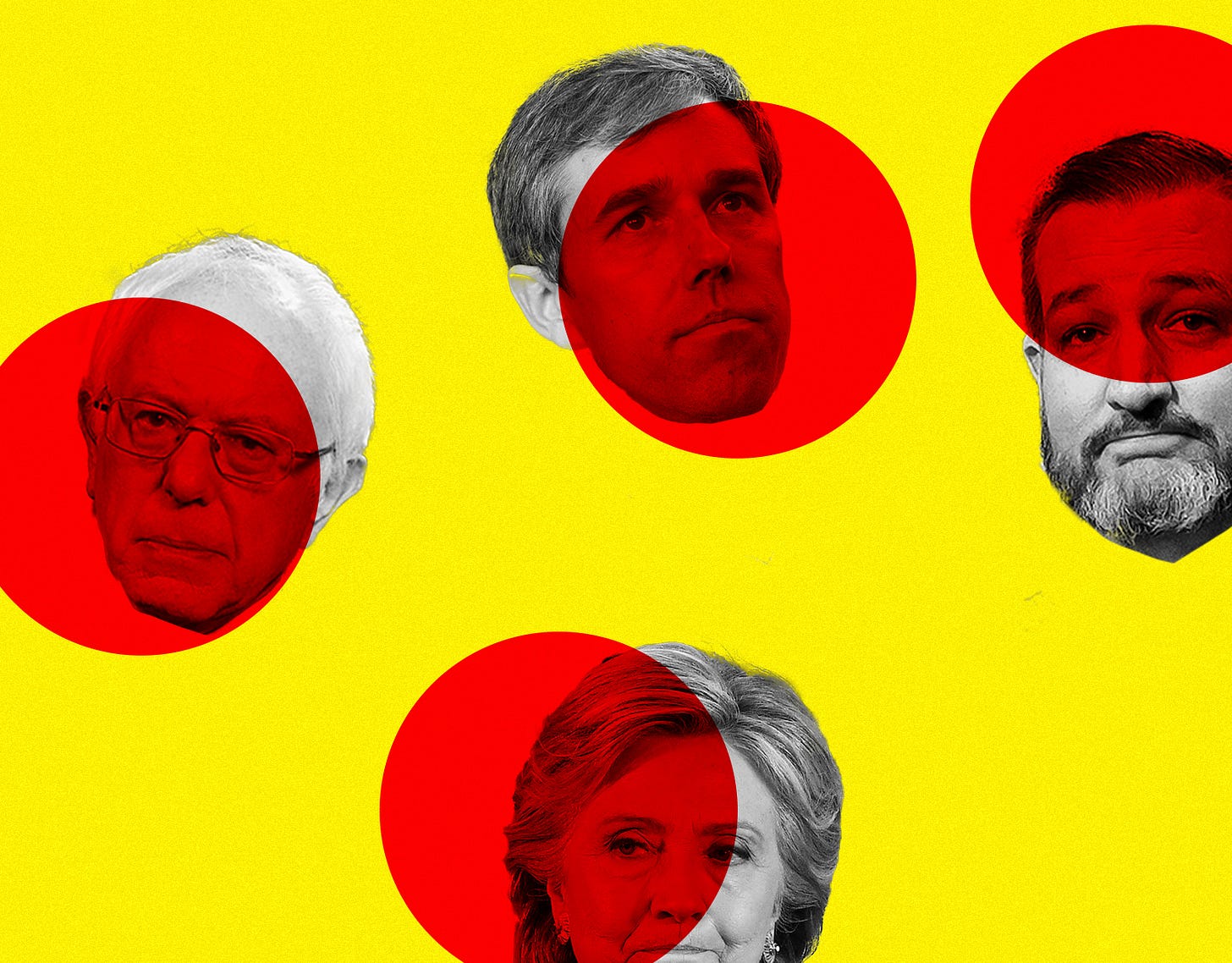Beto's Law Strikes Again
Don’t confuse voters hating your opponent with voters loving you.
A word of warning for anyone running for elective office in America: Don’t confuse voters hating your opponent with voters loving you.
We’ll call it Beto’s Law.
Bernie Sanders learned last night that running one-on-one against Hillary Clinton—the second-most unpopular presidential candidate in American history—is much easier than running against, well, anyone else.
It’s a lesson Donald Trump may soon learn, too.
Our politics has lately been dominated by negative polarity. People know more about what they’re against than what they’re for. And in 2016, voters were against Hillary Clinton. Bigly. I hear it in every focus group I conduct with reluctant Trump voters: “I didn’t vote for Donald Trump. I voted against Hillary Clinton.”
And it’s clear from Biden’s complete romp over the last two weeks that it was that same sentiment driving support for Bernie Sanders in 2016. Because while Bernie beat Clinton in places like Michigan, Maine, and Minnesota four years ago, Biden wiped the floor with Bernie in those states this time.
In 2016, Bernie pulled out a victory in Michigan with 49.7 percent of the vote. He won in 73 of Michigan’s 83 counties.
On Tuesday, Biden won 52.9 percent of the vote, and every single county.
Maine had a caucus instead of a primary in 2016, and Bernie won it handily with 64.3 percent of the vote. Four years later, in what was effectively a four-way race, Biden won with 34 percent to Bernie’s 32.9 percent.
In Minnesota, Bernie took 61.6 percent of the vote in the 2016 caucus. This time Biden took first place in a split race with 38.6 percent to Bernie’s 29.9 percent.
Bernie didn’t change. (He never does.) But his opponent did. Democratic voters like Joe Biden. He was the popular vice president to a very popular two-term president.
African Americans like him.
Women like him.
White working-class voters like him.
Suburban voters with college degrees like him. (And they’re turning out in record numbers.)
I even hear from lots of disaffected Republicans who like him.
Enough people like Biden that he was able to survive the first three nominating contests, in which his results ranged from disappointing to dismal. Enough people liked him that he was able to lap Sanders in the delegate race on Super Tuesday, outperforming even the most optimistic expectations for his campaign. And he did it with a modest bank account (by campaign standards), without a “ground game,” and without a single stand-out debate performance.
Sure, young people might not be sold on him. But they’re not really sold on the whole concept of “voting,” either.
Like Beto O’Rourke without Ted Cruz, Bernie Sanders will have to come to grips with the fact that he’s not as popular as he thought he was after 2016.
And so will Donald Trump. Despite claiming a “massive, landslide victory,” Trump’s 2016 success relied on fewer than a total 80,000 voters fortuitously distributed in three states—and that was running against Hillary Clinton, whose net favorability was -5 on election day. (Trump’s was -25.)
Biden has +5 net favorability according to a recent poll; Trump’s is net -19. And falling.
November is a long way away. Everything could change. Biden could tank. Trump could see a surge of popularity thanks to his competent, calm, and professional handling of the coronavirus.
But regardless of what happens, the basic dynamics of the 2020 race won’t be nearly as easy for Trump as they were in 2016.
Because a bad candidate makes everyone else look better and smarter than they really are.
Just ask Bernie.



